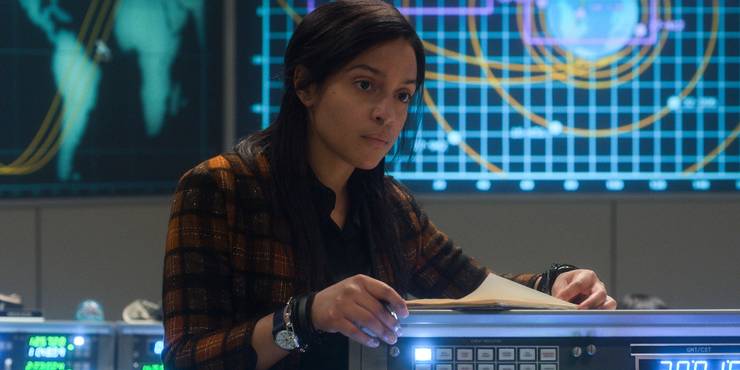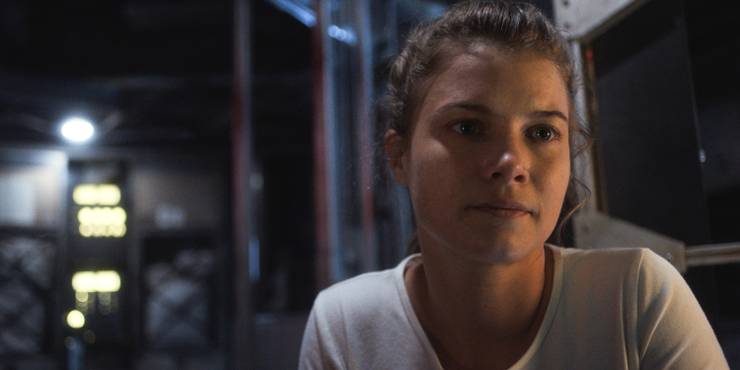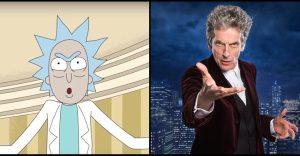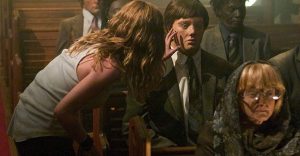For All Mankind Season 2 Ending Explained

Warning: For All Mankind season 2 SPOILERS ahead
For All Mankind season 2 takes the Apple TV+ series to another level. Ronald D. Moore’s alternative history sci-fi series is a reimagining of what might have happened if the Soviets had beat the Americans to the moon. Skillfully wrapping up the show’s increasingly complex season 2 narrative in the final episode, For All Mankind perfectly sets the stage for season 3 and beyond.
A decade after season 1, For All Mankind season 2 opens in 1983. The show continues to follow the main characters from the first season while introducing some new faces and bringing some of the supporting cast members into the fold. Ed (Joel Cinnamon) and Karen Baldwin (Shantel VanSanten) have adopted a daughter, Kelly (Cynthy Wu). Tracy (Sarah Jones) and Gordo Stevens (Michael Dorman) are divorced but not out of each other’s lives thanks to NASA and their two grown-up sons. Dani (Krys Marshall) finally gets her own mission. Molly (Sonya Walger) saves a life, but at a cost. Ellen (Jodi Balfour) rekindles her relationship with Pam and takes on a more commanding role at NASA. Margo (Wrenn Schmidt) reunites with the young Aleida (Coral Peña) – who is now a brilliant engineer – while forging new relationships with an unlikely Soviet ally named Sergei. Meanwhile, the Jamestown Colony has grown in the last decade – along with the Cold War – which introduces a whole new set of characters and conflicts into the story in For All Mankind season 2.
The many diverging plotlines in For All Mankind season 2 converge in the final episodes, as the conflict between the U.S. and the Soviets comes to a head on the moon. Things escalate after weapons are introduced into the Jamestown Colony, leading to both American and Soviet casualties as the penultimate episode ends on a cliffhanger. This is where For All Mankind’s season 2 finale, “The Grey” picks up. Ultimately, the show is about how the past changes and shapes the future, and it emphasizes how several individual choices can have a big hand in the way things turn out. The series takes a look at how a few decisions made by a handful of people ultimately changes the future – not just of one country, but of the world, and the universe at large. In For All Mankind season 2, we see the butterfly effect in action.
What Happened in For All Mankind Season 2

For All Mankind manages to wrap up the season 2 storylines and save the world by the end of the finale episode before setting up For All Mankind season 3 in the final scene – all while keeping the historically accurate plot elements straight along with the alternative history. This is a testament to the masterful plotting work and story development creator Ronald D. Moore and co-showrunners Matt Wolpert and Ben Nedivi have put into the series from the beginning. Aside from dropping clues as to where For All Mankind is headed in season 3, the show also leaves a few scenarios open for further exploration in the coming seasons.
One of the biggest questions at the end of season 2 is what will happen to Margo. The season 2 finale hints at how she may already be unknowingly working for the Soviets. There’s also a chance we could see Ellen become the first female president of the United States. It’s hinted at in season 2 when one of Reagan’s former political campaign managers visits Ellen and Larry’s home. It may not happen in For All Mankind season 3, but season 2 seems to be foreshadowing her eventual political rise. Having a former astronaut as the leader of the free world would make an extended space race seem more plausible. We also don’t know what will happen to Molly in the future as she’s already starting to suffer the effects of radiation. Will she go blind – or will there be some cure for glaucoma by the ‘90s? It’s possible that the technology could be there in the show’s alternative reality.
For All Mankind: A Utopian Universe

Moore has said that his goal with For All Mankind was to imagine an ideal “what-if” scenario that asks how the world as we know it might be a better place if things had turned out differently in the past. For All Mankind season 2 continues to dissect this question as it looks into the future and how the characters’ decisions in season 2 will have an impact on the next generation. When campaign manager Lee Atwater visits Larry about Ellen’s potential political future, he uses the world of fake wrestling – which became hugely popular in the ‘80s – as a metaphor for this idea. Explaining how wrestling is the best sport due to its obvious dishonesty, he tells Larry that “people crave drama more than truth.” Hearing this line, viewers can’t help but think that the show’s creators are speaking directly to them.
In Moore’s utopian universe, drama is better than reality. Even in the non-fiction retelling of our shared history – the facts portrayed in the media and history books – there are alternative versions and different perspectives. The truth is complex. And as Moore has shown, you can tell the truth in fiction. Altering the facts, in this case, doesn’t change the narrative truths that exist in For All Mankind. Viewers are drawn to the show because it’s easy to see themselves in the characters and relate to the characters not as astronauts, but as human beings. “We’re adapting history,” co-showrunner Ben Nedivi told Syfy Wire. “And the fun of that is picking and choosing the things that change, but also the things that didn’t change.” Nedivi said that one of the most fun aspects of creating the show was finishing the stories that never got their chance in real life. For All Mankind seeks to create an ideal version of what could have happened. Starting with one event – the moon landing – a single change ultimately impacts how things will turn out for decades to come.
For All Mankind: Time Jump To 1995 & Life On Mars

For All Mankind drops clues about the time jump and future storyline as Mars is a topic of discussion throughout Season 2. In episode 7, Ellen talks about leaving NASA for a private company in order to get to Mars, and earlier in the season she pushes Tom for a Mars mission after she gets back from the moon. The finale ends with someone stepping out onto the surface of Mars. It’s now 1995. Along with setting up the next stage of the space race, For All Mankind’s time jump raises the question of who might become central characters in season 3. Eventually, the older astronauts will have to retire, opening the door for younger characters and new storylines.
The show will continue to blend fact with fiction in season 3. In the 1990s, the US really did expand exploration to Mars, but the missions involved mostly remote observation probes. The final scene of the season 2 finale makes it clear that in the world of For All Mankind, Mars exploration will be taken much further than the current reality. The time jump also indicates that characters like Danny Stevens, Kelly Baldwin, and Aleida Rosales could be taking a more central role in the narrative. While each of them started as children in the series, they’ve each encountered obstacles and experiences in life that have caused them to grow up fast. Aleida has been on her own for the past decade, and both Danny and Kelly often behave more maturely than their parents, as they are each forced to play the role of caretaker at times. If Aleida becomes a central character – which seems likely since she’s already working for NASA – hopefully, more will be revealed about what happened to her father. It’s known that he was deported and Aleida stayed in the U.S., a heartbreaking plot element in the first season, but it’s not known what their relationship is like now or how he is doing back in Mexico as his character is never addressed in season 2. Based on her role in season 2, it’s easy to see how Aleida could end up becoming a leading figure at NASA in future seasons.
Why Tracy & Gordo Had to Die in For All Mankind Season 2

Given the show’s idealized world view, it was pretty shocking to see Tracy and Gordo die at the end of the For All Mankind season 2 finale. From the beginning, the series presents audiences with the question of what it means to be a hero. Both Gordo and Tracy are seen by the public as heroes in season 2 – Gordo begins the series as a washed-up astronaut who is forced to repeat the lie he, Dani, and Ed concocted at the end of season 1, and Tracy’s fame skyrockets after saving Molly in the previous season. But it’s not until the final episode of season 2 that they actually become real heroes – saving everyone at Jamestown and the planet from nuclear fallout. In doing so, they both make the ultimate sacrifice. As hard as it was to see these two characters die in the end, it feels poetic – this end to their long romance and their shared fate. Their character arcs are complete, and in a number of ways, this really is the perfect ending to their story. This is truly a love story for the ages – it’s also one that’s very much of our time. Had they lived, Gordo and Tracy may have become more secondary characters as the show jumps to the ‘90s and the younger astronauts begin to take center stage in the coming seasons. This way, their story ends on a high note, as they will be remembered as true heroes.
For All Mankind Finale Title “The Grey” Explained

The title of the season finale, “The Grey,” also speaks to one of the main points of For All Mankind season 2 – that things are rarely black and white. There are always shades of grey. Karen talks about this concept in the penultimate episode when she confesses to Ed that she’s cheated on him. She tells Ed that life is more complicated than his black and white view of things. And that most people live in the grey. This idea is something each of the main characters must grapple with through season 2. And it is an overarching theme of the series.
This is portrayed in the season 2 finale when Ed decides to destroy the Sea Dragon rather than shoot at Buran, which would kill all the Soviets onboard. At first, he thinks the only option is to fire at Buran before they fire at the Sea Dragon, but then he has an epiphany and realizes there’s a third way – destroy the cargo ship. This ends up being the right choice, and each of the main characters must face similar choices in For All Mankind season 2. Gordo and Tracy find a way to save Jamestown together despite the odds being stacked against them. Molly disobeys orders in order to save a life, potentially sacrificing her own. Margo seemingly betrays her country when she shares information with Sergei in order to save Soviet lives. Dani disobeys orders by proceeding with the Apollo-Soyuz handshake despite Houston’s order to come home. And Ellen disobeys Reagan’s orders when she ultimately gives Dani the go-ahead. Each of these decisions will end up saving thousands of lives as the threat of nuclear war subsides in the end – for now.
The Real Meaning Of For All Mankind Season 2

On the surface, For All Mankind is a smart, sci-fi story in an alternate universe, and watching how the show takes the history of space exploration and turns it on its head is intriguing, but equally riveting are the relationships between the characters – the astronauts and their families orbiting around NASA. As the main characters’ stories attest, For All Mankind season 2 is about the quest for greatness – greatness for one’s nation and on an individual scale. What it means to be a hero in the eyes of the public, making a name for oneself, inspiring the next generation, and what the characters have to sacrifice in order to become “great.” It’s about the individual choices that can lead to greatness, and how those choices can end up shaping the future for all mankind.
It’s the characters who take the drama to the next level in For All Mankind season 2. But the story is also bigger than any one character or individual. As the show’s title indicates, this is a story about mankind as a whole, and it raises questions about where human beings are headed. The future possibilities – on earth and in space. In this case, “The Grey” could also be referring to something still unknown. An option that hasn’t been thought of or presented yet. It symbolizes future possibilities and tells us that in this utopian storyline, not everything is clear yet. We don’t know how it’s going to turn out in the end, but as the John Lennon quote from the end of the season finale says “If it’s not okay, it’s not the end.” The series creators seem to be hinting at the fact that there’s still a lot of the story left to tell in For All Mankind.
About The Author

















